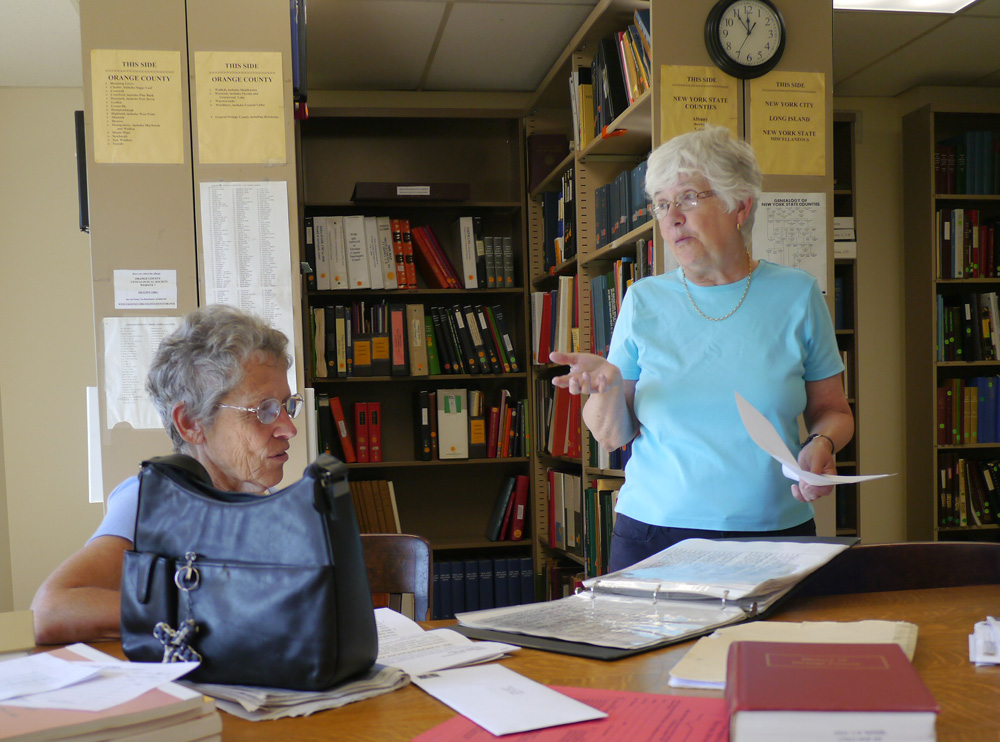Genealogy has taken me many places including Scotland, Philadelphia and Winnipeg. Last week my husband and I visited New York State to research my three-times great-grandmother’s family, the Thompsons. I wanted to find out whether there was a link between the 18th century Thompson family of Goshen, Orange County, New York and the John Thompson family of Sophiasburgh Township, Ontario, Canada.
Orange County is located in the Hudson Valley, about 60 miles (100 km) north of New York City. It has gentle hills, historic villages and rich agricultural soil. The area was first acquired from the Munsee Indians in 1703. New York State is not an easy place to do genealogy research, especially for this early period before there were no vital records or detailed censuses. My ancestors were Presbyterians and I did not expect to find a neatly microfilmed database of church records. But the Orange County Genealogical Society (OCGS) has a research library in Goshen, staffed by a handful of knowledgeable volunteers, and an expert on the Thompson family lives nearby.
The trip was worth the effort and I came home with enough information to show that these families are related. (I’ll explain in another post.) With that link established, I can now take the male Thompson line to Ireland in 1729.

The Thompsons are confusing because there were several families of that name in Orange County during the 18th century, including individuals in every generation named John, George, William and James Thompson. There were even two George Thompsons, both born in 1719, both married to women named Elizabeth, and both died in 1782. One was a soldier in the American Revolution, the other was not, and more than one descendant has confused them.
I tried to prepare thoroughly before I left home. First, I researched my three-times great-grandmother Elizabeth “Betsey” Thompson’s siblings and children in Ontario. Their death certificates were particularly helpful since some indicated place of birth. I should have spent more time on Betsey’s father, John Thompson, his siblings, aunts and uncles and nieces and nephews. It would have been easier to sort out Goshen’s Thompson families if I had known more about them.
When we got to the OCGS, I looked through several excellent collections of research done by now-deceased Orange County genealogists. There were also several family histories of the Thompsons and four large file folders full of query letters and family group sheets submitted by members. Unfortunately, the documents in the file folders were mixed up. I suspect that, when it came to filing, the society’s volunteers had as much trouble sorting out the Thompsons as I did. I photographed all the documents I thought were relevant and brought them home for a closer look.
After lunch, we visited the person who knows the most about this family in her big old house in the countryside. Elmire Conklin’s husband was a Thompson descendant and she has been researching them for more than 35 years. She has a degree in botany, and that scientific training helped make her an excellent genealogist. In an article she wrote for the OCGS Quarterly (May, 1991), and in her correspondence with other researchers, she zeroed in on inconsistencies and proposed logical answers to some of the questions that arise about this family. The whole experience reminded me of three things. First, we cannot just do genealogy research online. Second, we have to be grateful for the generosity and hard work of genealogists who have preceded us. Third, we have to question their work: when family stories and genealogies contain errors, those mistakes are easily passed down through the generations and they are difficult to correct.
This article has also been posted on https://genealogyensemble.com
See also:
Janice Hamilton, “Looking for the Thompsons of Sophiasburgh,” Writing Up the Ancestors, https://www.writinguptheancestors.ca/2015/05/looking-for-thompsons-of-sophiasburgh.html
Research Remarks:
The Orange County Genealogy Society website is at www.ocgsny.org/. The society does not have an e-mail address; if you want to contact them, you have to do so by snail mail. If you intend to visit, take note of the hours: the research library is only open two mornings and one full day a week.
I have several other ancestral families in New York State, so I recently joined the New York Genealogical and Biographical Society, www.ocgsny.org/. It now partners with Findmypast.com to make its records available, and The New York Researcher magazine it publishes is extremely helpful in explaining where and how to find New York records. In addition, the society recently published the must-have New York Family History Research Guide and Gazetteer.
